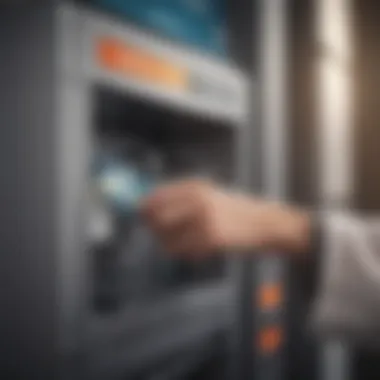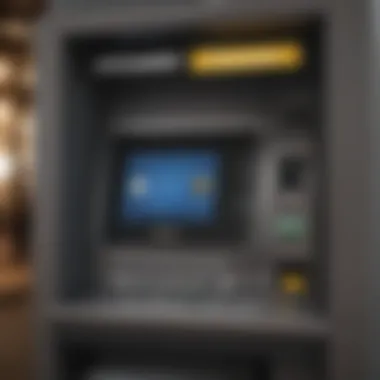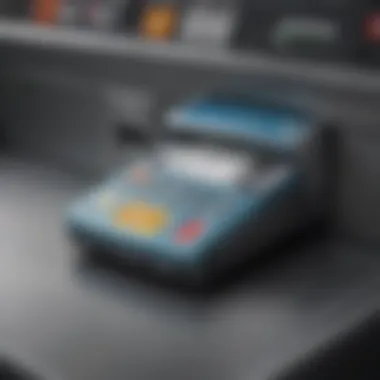Navigating ATM Transactions: Credit Card Insights


Intro
Understanding how to manage your finances is essential in today's complex economic environment. Using credit cards at ATMs offers convenience, but it also comes with its own challenges and risks. This article will guide you through the various aspects of using credit cards for ATM transactions, including potential fees, impacts on credit scores, and strategies for responsible usage and financial management.
As we delve into these topics, we hope to clarify what you need to know before utilizing your credit card at an ATM, ensuring that you make informed decisions regarding your banking activities. The discussion will provide insights specifically tailored for individuals keen on improving their financial health and credit management.
Understanding Credit Status
What is Credit Status?
Credit status refers to the overall health of an individual's credit profile. It is a reflection of how well a person has managed their credit accounts over time. Several elements contribute to this status, and knowing one's credit standing is important for making informed financial Decisions.
Key Factors Affecting Credit Scores
Multiple factors influence credit scores, including:
- Payment History: This accounts for a significant portion of your score. Late or missed payments can greatly decrease your score.
- Amount Owed: The total debt you have compared to your credit limit, known as credit utilization, also plays a role. Lower utilization is usually better.
- Length of Credit History: The longer your credit history, the more data lenders have to assess your reliability.
- Types of Credit Used: A mix of credit types (revolving credit, installment loans) can positively influence your score.
- New Credit: Opening several new accounts in a short period can indicate risk and lower your score.
Importance of Knowing Your Credit Reports
Regularly checking your credit report is crucial. It provides you with an overview of your credit activity and can highlight any inaccuracies or fraudulent activity. Being aware of your credit report helps you address issues before they become significant problems.
How to Obtain Your Credit Reports
You can obtain your credit reports for free from major credit bureaus like Equifax, Experian, and TransUnion. In many countries, you are entitled to at least one free report per year. Checking your report regularly helps you stay informed and take necessary actions if needed.
Strategies to Improve Credit Score
Effective Methods for Boosting Credit
Improving your credit score requires a strategic approach. Some effective methods include:
- Paying Bills on Time: Timely payments are crucial for maintaining and improving your credit score.
- Keeping Balances Low: Aim to use no more than 30% of your total credit limit.
- Avoiding Unnecessary Credit Inquiries: Limit the number of times you apply for new credit within a short period.
Managing Existing Debt
It is vital to develop a plan for managing existing debt. You might consider consolidating debt if it becomes overwhelming. This can potentially allow for lower interest rates and easier management.
Importance of Timely Payments
Late payments can significantly harm your credit score. It is advisable to set reminders or automate payments to ensure bills are paid on time.
Utilizing Credit Responsibly
Using credit cards judiciously can enhance your credit profile. Avoid using credit for non-essential purchases, and try to pay off the balance in full each month.
Personalized Recommendations for Credit Products
Assessing Your Financial Needs
Before selecting a credit product, assess your financial needs carefully. Consider your spending habits, financial goals, and how the credit product aligns with these factors.
How Recommendations Work
Many financial service providers offer personalized recommendations based on your credit history and financial behavior. These tools often assess various credit products to find the best match for you.
Best Credit Cards for Building Credit


There are specific credit cards designed for those looking to build their credit. For example, capital one secured Mastercard can be an excellent option for individuals with limited credit history.
Ideal Loans for Bad Credit
Finding loans when you have bad credit can be challenging, but some lenders specialize in providing options for individuals with less-than-perfect credit. Researching these options is essential.
Actionable Insights and Next Steps
Creating a Personalized Financial Plan
Developing a financial plan tailored to your situation will help you achieve your financial goals. This plan should include budgeting, saving, and credit management strategies.
Resources for Continuous Learning
Continuous learning in finance can augment your understanding. Websites such as Wikipedia and Britannica provide valuable insights into financial management topics.
Importance of Monitoring Your Credit Status Regularly
Regularly monitoring your credit status allows you to make informed decisions about your financial health. Several services offer ongoing credit monitoring for a fee.
How to Track Progress and Set Goals
Establish clear financial goals and regularly review your progress. Adjust your strategies as necessary to stay on track. Tools for budgeting and financial planning can assist with this process.
It's crucial to remain proactive about your financial health. Understanding the implications of using a credit card at ATMs will help you make more informed decisions in managing your finances.
Understanding ATM Functionality
Understanding the functionality of Automated Teller Machines (ATMs) is vital for effectively navigating transactions, especially when using a credit card. ATMs serve as essential components of modern banking, offering customers quick access to cash and other banking services outside of traditional branch hours. Grasping how they work can lead to better decision-making, particularly in terms of fees and potential pitfalls of credit card usage at these machines.
The Role of ATMs in Modern Banking
Automated Teller Machines have revolutionized personal finance management. They provide users with a convenient way to handle cash withdrawals, deposits, transfers, and even check balances. The integration of ATMs into daily banking has extended banking accessibility, making it feasible for individuals to perform transactions without visiting a bank.
One notable feature of ATMs is their ability to support various banking functions beyond cash withdrawals. For instance, users can also pay bills and top up mobile accounts in some regions. This versatility makes ATMs an indispensable tool in contemporary banking, catering to a wide audience.
With the rise of digital banking, the role of ATMs has evolved further. They now compete with online banking solutions by providing essential services that continue to pique user interests. Users appreciate the ease of accessing cash, which is particularly beneficial in emergencies or unforeseen situations. As a result, understanding ATM functionalities is not just beneficial; it is crucial for modern banking experiences.
How ATMs Communicate with Banks
ATMs function through a sophisticated network of communication between the machine and the banking institution. When a user initiates a transaction, the ATM sends a secure connection to the bank's server, which verifies the card's details and the user's account status.
This interaction involves several steps:
- Card Reading: The ATM reads the magnetic strip or chip on the credit card, gathering essential account information.
- Encryption: The data is then encrypted for security as it is transmitted to the bank.
- Transaction Processing: The bank processes the request for funds or the intended transaction, checking account balance and credit limits, upon which an approval or denial is issued.
- Response Delivery: The ATM receives and displays the response outcome to the user.
Connection speed remains critical in this process. A delay during communication can lead to user frustration and possible transaction errors. Additionally, secure communication protocols are imperative to protect sensitive information and ensure that the transaction is not compromised.
ATMs rely on secure and effective communication with financial institutions to complete transactions, emphasizing the importance of technology in personal banking.
In summary, a thorough understanding of ATM functionality not only aids in easing monetary transactions but also helps users make informed decisions about their banking practices.
Using Credit Cards at ATMs
Using credit cards at ATMs offers a convenient way for individuals to access cash, especially during emergencies. This section evaluates the importance of credit cards in ATM transactions, shedding light on various key aspects. Many people might be unaware of how to effectively utilize their credit cards for cash withdrawals or the potential consequences associated with such transactions. Understanding these nuances can lead to informed decision-making.
Credit Card Withdrawal Mechanism
Withdrawals using a credit card at an ATM are possible through a mechanism designed for cash advances. When a credit card is inserted into the ATM, the machine communicates with the bank that issued the card. The ATM requires the card holder to enter a Personal Identification Number (PIN), which is typically needed for cash advances. This verification helps ensure that the transaction is legitimate and authorized.


During the withdrawal process, the ATM checks the available credit on the user's card. If approved, the machine dispenses the requested amount of cash. It is important to note that cash advances often incur higher fees and interest rates than standard purchases. Thus, comprehending the withdrawal mechanism assists users in proactively managing the costs associated with this mode of transaction.
Types of Credit Cards Accepted
Not all credit cards function the same way at ATMs. Generally, major credit card networks, such as Visa, Mastercard, and American Express, are commonly accepted. However, individual card issuers might set specific restrictions. Here are some factors to consider:
- Network Compatibility: Ensure the ATM displays the logo of your card network.
- Issuing Bank Policies: Some banks impose limits on cash advances based on customer accounts.
- Card Type: Standard credit cards usually support ATM transactions while prepaid or secured cards might not.
Understanding the types of credit cards accepted can help users maximize their options when needing cash from an ATM.
Steps for Using a Credit Card at an ATM
Using a credit card at an ATM can be broken down into straightforward steps to ensure a smooth process:
- Locate an ATM: Find an ATM that accepts your credit card, ensuring it belongs to your card’s network.
- Insert Your Card: Place the credit card into the ATM, following any prompts on-screen.
- Enter PIN: Input your Personal Identification Number. This step is crucial as it confirms user identity.
- Select Transaction Type: Choose 'cash withdrawal' or 'cash advance' when given options.
- Enter Amount: Type in the amount of cash you wish to withdraw, adhering to any limits in place.
- Collect Cash and Receipt: After confirmation, collect your cash and any transaction receipt provided.
By following these steps, users can recognize the critical aspects of the transaction process, helping them navigate cash needs more readily while minimizing fees and potential complications.
Implications of Using Credit Cards at ATMs
Using a credit card at an ATM involves several implications that deserve careful consideration. The accessibility of cash through credit cards can be a double-edged sword; on one hand, it provides convenience, while on the other, it can lead to unexpected financial burdens. This section will explore crucial elements such as fees, interest rates, and the impact on credit scores associated with this practice. By understanding these implications, users can make informed and strategic decisions regarding their financial activities.
Potential Fees and Charges
When withdrawing cash from an ATM using a credit card, it is essential to be aware of the various fees that may apply. These fees can be broken down into different categories:
- ATM Usage Fees: These fees are often charged by the ATM owner. If you are using an ATM that is not affiliated with your credit card issuer, you might incur additional costs. This is especially common in locations like convenience stores or airports.
- Cash Advance Fees: Credit card issuers typically charge a cash advance fee, which can be a percentage of the amount withdrawn or a flat fee, whichever is higher. These costs can accumulate quickly, making what seems like an easy transaction more expensive.
- Foreign Transaction Fees: If you use your credit card internationally, you may be subject to a foreign transaction fee, which is additional to standard ATM fees. This can make using credit cards for withdrawals abroad quite costly.
Understanding these potential fees is vital. They can significantly affect your overall finances, especially if you are not well-informed.
Interest Rates and Cash Advances
Unlike typical purchases made with a credit card, cash advances come with distinct characteristics. The interest rate for cash advances is usually higher than that for regular purchases, which can lead to compounded costs over time. Important points to consider include:
- Immediate Interest Accrual: When you withdraw cash, interest starts accruing immediately, without any grace period. This is a crucial distinction from regular card purchases, where you often have a month to pay before interest kicks in.
- Potential for Debt Accumulation: Because of the higher interest rates and immediate accrual, if you do not pay back the cash advance promptly, it can quickly grow and become difficult to pay off. This can severely impact your budget and overall financial health.
- Lack of Rewards: Generally, credit card transactions that offer rewards or cashback do not apply to cash advances. Therefore, you miss out on potential benefits while incurring additional costs.
Impact on Credit Score
Using a credit card at an ATM for cash advances can also affect your credit score in several ways. Here are the key points to understand:
- Credit Utilization Ratio: Cash advances increase your credit utilization ratio, which is the amount of credit you are using compared to your total credit limit. A high utilization ratio can negatively impact your credit score.
- Payment History: Failing to pay back the cash advance promptly can result in late payments, which significantly harm your credit score. Making timely payments is crucial for maintaining a positive credit profile.
- Frequent Use of Cash Advances: Regularly relying on cash advances may signal financial distress to lenders. This behavior can lead to a perception of risk, making future lending more challenging or resulting in increased interest rates.
Understanding these implications is vital when considering using credit cards at ATMs. It empowers individuals to navigate their financial choices more judiciously and to assess whether such transactions align with their broader financial strategies.
Advantages and Disadvantages
This section examines the advantages and disadvantages of using credit cards at ATMs, an essential topic within the broader discussion of electronic banking. Understanding both benefits and risks allows users to make informed decisions regarding their financial practices.
Benefits of ATM Cash Withdrawals with Credit Cards
Using a credit card at an ATM can offer several benefits, particularly in situations where cash is needed quickly. One advantage is that it provides immediate access to credit funds. This can be crucial during emergencies, such as when unexpected expenses arise. The convenience of withdrawing cash from an ATM rather than visiting a bank branch or relying solely on debit cards can save time.
Additionally, many credit cards offer rewards programs. When a user withdraws cash using their credit card, they may still earn points or cashback, depending on their card's terms. It's a distinct advantage that could enhance the overall value of credit card use.
Moreover, using credit cards for cash withdrawals can aid users in managing their finances. If one is adept at tracking and paying off credit card balances promptly, utilizing a credit card for ATM withdrawals may not lead to increased debt. Users can leverage their available credit while keeping their cash flow flexible.
Risks Associated with Credit Card ATM Use


However, using credit cards at ATMs is not without its risks. One significant drawback is the potential for substantial fees. Banks typically impose transaction fees, and these fees can stack when using an ATM that is not part of the card issuer’s network. This can make cash withdrawals through credit cards much more expensive compared to debit card use.
Another risk lies in interest rates. When cash is withdrawn on a credit card, it is usually treated as a cash advance. Cash advances often attract higher interest rates compared to regular purchases, and interest begins to accrue immediately. This can lead to increased financial burden if balances are not paid off swiftly.
Furthermore, frequent cash withdrawals can impact a user’s credit score negatively. Credit utilization, which is a metric used in calculating credit scores, could increase if cash advances are not managed carefully. Users might find themselves in a cycle of debt that can be difficult to escape.
"Cash advances from credit cards should be approached with caution to avoid unforeseen financial pitfalls."
Considering these points, it is evident that while there are benefits to using credit cards at ATMs, there are also significant risks that cannot be ignored. An informed approach is necessary to maximize advantages and mitigate potential disadvantages.
Alternatives to Credit Card ATM Withdrawals
Exploring alternatives to using credit cards at ATMs is essential for maintaining financial prudence. While credit cards provide a convenient option for cash withdrawals, they can lead to unexpected fees and high interest rates. Understanding other available options can empower users to make informed decisions, enhance their financial health, and avoid pitfalls associated with credit card usage. Below are several alternatives that individuals can consider.
Using Debit Cards for Withdrawals
Debit cards are a straightforward alternative for obtaining cash from ATMs without the baggage that comes with credit cards. They allow access to the funds already in the user's bank account. This means no borrowing is involved, eliminating interest rates or cash advance fees.
- Direct Access to Funds: Users can withdraw only what is available in their account. This practice promotes responsible spending, as it discourages excess withdrawals.
- Lower Fees: Most banks have affiliate networks, resulting in no transaction fee withdrawals at their ATMs. In contrast, credit card cash advances may incur higher fees and interest charges.
- Easier Budgeting: Using a debit card aligns with budgeting efforts by transparently showing available funds, avoiding overspending.
Mobile Payment Solutions
Mobile payment solutions are gaining traction as a method to manage finances without directly involving ATM withdrawals. Options such as PayPal, Venmo, or Apple Pay provide quick access to funds.
- Convenience: Users can make payments directly from their mobile phones without needing to visit an ATM.
- Instant Transfers: Funds can be transferred between accounts instantly, eliminating the need for cash.
- Security Features: Many mobile applications offer advanced security options like biometric authentication, making them a safe alternative.
Mobile payment solutions can streamline cash management, offering a balance between convenience and security.
Digital Wallets and Their Benefits
Digital wallets like Google Wallet and Samsung Pay allow for seamless transactions without the need for physical cash or credit card advances. They serve as a bridge between a bank account and everyday payments, enhancing ease of use.
- Inclusivity: Digital wallets can store various payment options, including debit cards, making accessing cash straightforward.
- Rewards Programs: Many digital wallets integrate rewards systems that encourage use, providing users with benefits for transactions made.
- Track Spending: They often come with expense tracking features, assisting users in managing finances more effectively.
Ultimately, exploring these alternatives offers individuals options that foster better cash management while mitigating the risks associated with withdrawals on credit cards. By adopting different payment methods, users can maintain control over their finances and reduce the potential for harmful debt levels.
Best Practices for Responsible Credit Card Use
Using credit cards at ATMs can be convenient but also fraught with risks. Adopting best practices for responsible credit card use can greatly reduce potential financial pitfalls. Responsible use ensures that individuals maintain their financial health while taking advantage of the benefits that credit cards can offer.
Setting Limits on Cash Advances
One of the most crucial steps when using credit cards at ATMs is setting limits on cash advances. This practice helps control spending and avoid falling into debt. Many credit cards allow users to withdraw a percentage of their credit limit. Therefore, knowing how much you can withdraw without overshooting your budget is vital. Setting cash advance limits can also protect you from impulse spending, which often leads to regret later.
Many people do not realize that cash advances incur higher interest rates compared to regular purchases. Additionally, these transactions often come with fees that can quickly add up. To prevent yourself from excessive fees, set a clear cash withdrawal limit that takes these factors into consideration. Make it a habit to review your spending regularly to ensure you stay within your set boundaries.
Monitoring Credit Card Activity
Constantly monitoring credit card activity is another critical practice. By frequently checking your credit card transactions, you can catch unauthorized charges early or identify patterns in your spending that may signal financial trouble. Many banks offer mobile apps that provide real-time notifications of transactions, making it easier to stay informed about your financial activity.
Moreover, reviewing your monthly statements is essential. This review should highlight any fees related to ATM withdrawals, both from your bank and the ATM operator. Being aware of these charges allows you to adjust your spending habits accordingly. It also aids in detecting any errors that may need to be disputed.
Finale
In this article, the discussion around using credit cards at ATMs is extensive and essential for anyone looking to manage their finances wisely. Understanding the implications of these transactions goes beyond the mechanics of withdrawal. It encompasses knowledge about fees, interest rates, and the potential impacts on one's credit score. By grasping these elements, users can make informed decisions that support their financial health.
Key Takeaways on Credit Card Usage at ATMs
Credit cards provide a convenient method for access to cash through ATMs, however, several key aspects deserve attention:
- Convenience: Using a credit card at an ATM offers immediate access to funds, especially in emergencies. However, this comes with associated risks.
- Potential Costs: Fees can accrue quickly. Always check for withdrawal fees charged by both the ATM and the credit card issuer, as this can significantly affect the cost of borrowing funds.
- Interest Rates: Cash advances from credit cards often incur higher interest rates than standard purchases. Awareness of this is crucial for preventing escalating debt.
- Impact on Credit Score: Utilizing credit cards for ATM transactions can affect credit utilization ratios. Staying mindful of balance levels can mitigate negative impacts on credit scores.
- Responsible Usage: Setting strict limits and monitoring transactions can lead to healthier credit card behavior. Always keep track of cash advances and their repayment schedules.
"Making informed financial decisions not only supports individual stability but fosters broader economic resilience."
Thus, credit card usage at ATMs demands careful consideration. By focusing on these takeaways, individuals can navigate the complexities of ATM transactions more effectively, ensuring their financial choices align with their broader goals. This knowledge ultimately contributes to better financial management and credit health.







